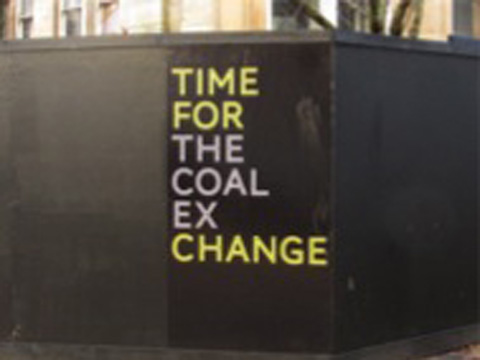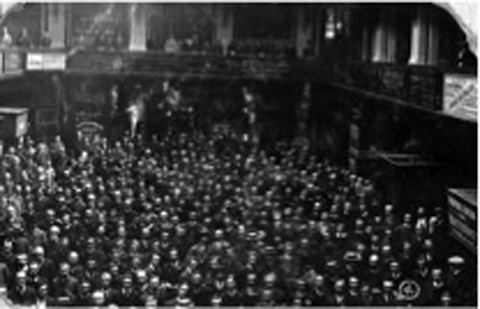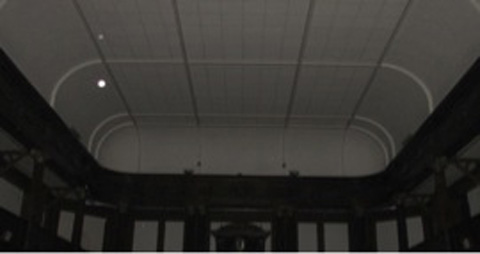From prosperity to disrepair, how the Coal Exchange fell from grace.
“Time for the Coal Ex Change.” This striking sign is the first thing you see when turning the corner leading to Mount Stuart Square. An area of the city that used to be a hive of activity is now eerily quiet with The Coal Exchange standing at the centre, unused and unloved. In its 128 years, the Exchange has served many purposes. From a place of business to a cultural hub, there have been multiple generations who care for this grand building but now it seems that it may not last forever.
For the last year, the Exchange has been closed to the public putting a sudden end to one of the biggest public spaces in the city. However, there is a ray of hope as a new group is attempting to save this historic building. Save the Coal Exchange Limited believe that this building is worth saving. But is there hope for the building or is this the end of the line for the Exchange.
Bricks and Mortar
The building was constructed between the years 1883 to 1886. The main orders of business that took place in the Exchange were to do with the shipping and moving of coal and it was one of the biggest economy drivers in Wales. Director of Save the Coal Exchange, Ian Hill explained how the building used to be a, “Cathedral of the Steam age.” With it high ceiling and intricate details that line the wall you can see why it invokes such a response from the director. When you enter the main hall today you can still pick out elements that tell the story of the buildings original use. Pointing towards the surrounding balcony, Ian comments how, “The main dealer’s offices used to be based up there and they used to shout down to the floor.” For many locals, one distinctive memory of the building is the wooden interior of the main hall with carved gargoyles looking towards the centre of the room. This took place in 1911, during a renovation of the main hall.
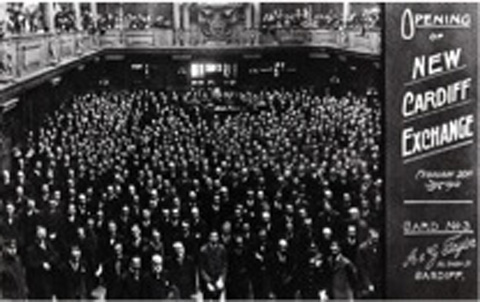 The main hall after its refurbishment in 1911. The wooden panel work still stands today. Image supplied by Save the Coal Exchange Limited
The main hall after its refurbishment in 1911. The wooden panel work still stands today. Image supplied by Save the Coal Exchange Limited
Uncertain times
Pulling out a picture of the last trading board, Ian showed how trading was still taking place in 1976. “Of course in 1976 you began to get the Thatcher government. When they closed the Welsh coal mines you also saw the closer of Cardiff as a port” he explained.
It was during this time that the Coal Exchange went though a few years of flux. There were many interested parties who thought that they could make use of the space but due to its grade two-listed status, there were limitation to how much work could be done on its infrastructure. At one point it nearly became the home of the Welsh Assembly and the Exchange experienced its first major renovation with the lowing of the ceiling the main hall. This meant that the large glass ceiling that used to provide lighting to the whole trading floor was suddenly blocked from view to provide a more effective space for public speaking a reduction of echo.
A place for culture.
In the end the Coal Exchange did not become the home for Welsh politics. Instead it became the host of various creative arts. Between the 1970’s and 1980’s it was a cultural hub for the city, hosting events and giving the creatives of Cardiff a home for their work. Ian mentioned how, “There were sound recording studios and indie film companies based here. I myself worked with Promo Cymru who was based at the Exchange.”
Bring the noise
In the later years leading up to the present day one of the Coal Exchange’s predominant functions was as a music venue. Reopening in 2009, the main hall for the first time in years was once full of people. But instead of shaking hands they were banging heads.
The venue offered has an impressive list of past acts coming through with the like of Manic Street Preachers, Arctic Monkeys, and Funeral for a Friend and Anthrax to name but a few.
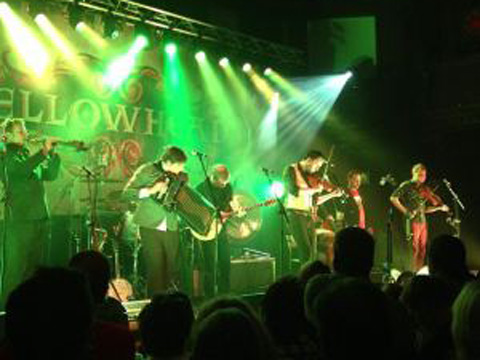 One of the last gigs to be held in the Exchange. Bellow Head performed in November 2012. Image supplied by Gavin Owen
One of the last gigs to be held in the Exchange. Bellow Head performed in November 2012. Image supplied by Gavin OwenSadly in 2013 the venue was officially closed down due to the council deeming it unsafe. Mike Johnson, lead tenant of the building, is now in a situation where he can no longer run events in the main hall. “The only reason he we have kept a presence is to keep it in good shape and to stop it being abandoned,” he explained.
Mike first entered the Coal Exchange in 1989 while working on a couple of art projects but now in 2014 he is still maintaining a presence. He explained why he thought it was important to keep the building alive. “There have been over a million people thought the doors with gigs and meals,” he explained. He went on to say that the building has affected so many people and for him it was time to give something back to the Exchange.
Time for a Change.
Whether financial or cultural, for over 100 years the Coal Exchange has played a major part in the changing face of Cardiff. It is clear to see why so many people are so passionate to keep it alive.
When speaking to members of Save the Coal Exchange it seems that they are desperate to simply open it up to the public once again. One thing that is clear from Save the Coal Exchanges work is that they are really keen to remember the buildings past. In a final word with Ian on what he hoped would happen to the exchange he comment, “We just need to open those doors again.”
But, until a decision is made and funding is acquired, this grand building will have to remain under its shroud of scaffolding and boards. Whether demolition or rejuvenation, in the next couple of years we are bound to see a change and the Exchange.

